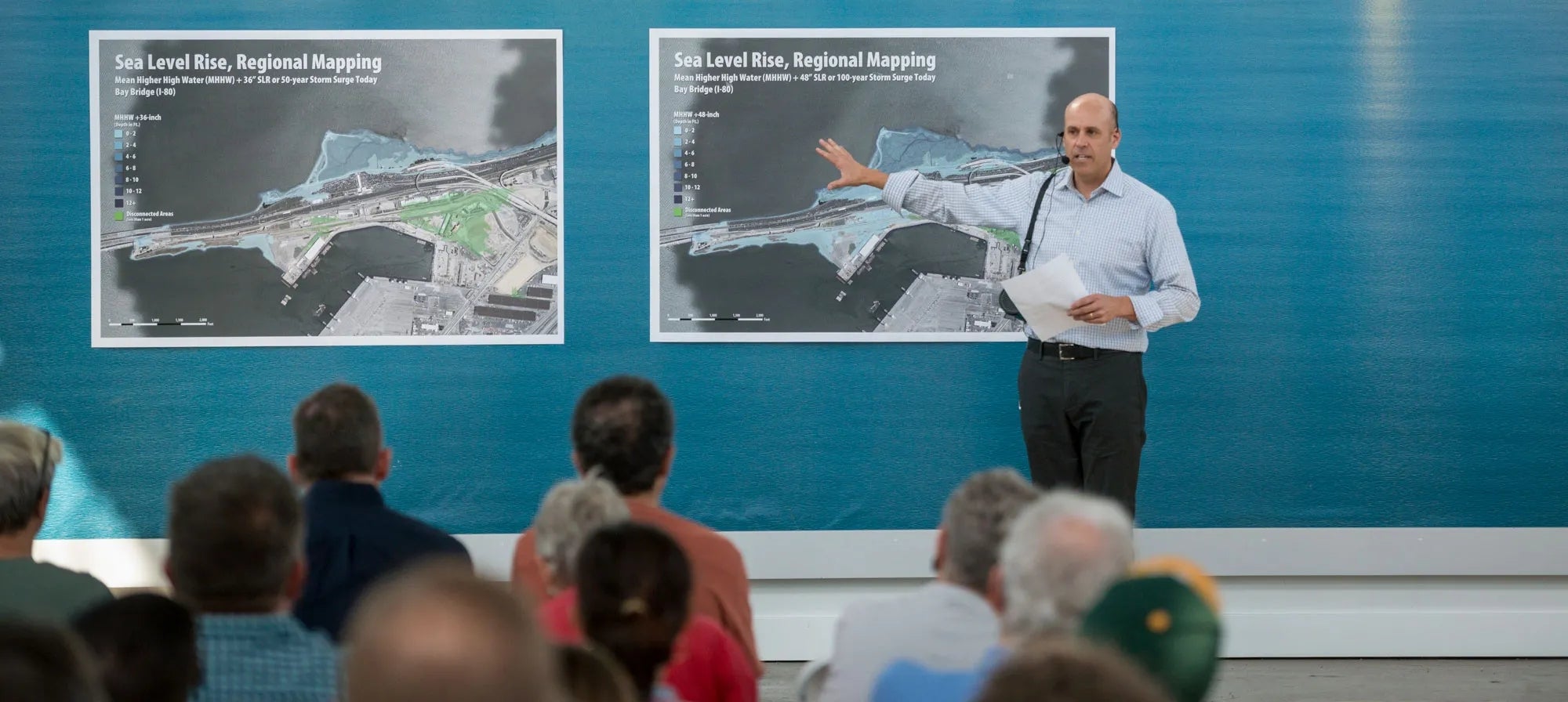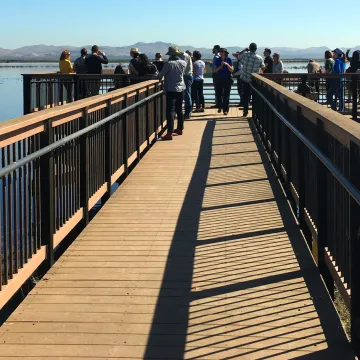
The number 10 seems to have special significance for the Bay Area when it comes to grappling with sea level rise, starting with the date of September 10, 2017. That Sunday was the day when local, regional and state officials gathered at the Port of Richmond to unveil the 10 winning teams selected in the Resilient by Design | Bay Area Challenge competition. Made up of high-powered architects, landscape architects, planners, horticulturists, artists engineers and the like from across the Bay Area and around the globe, these teams will each be assigned to one of 10 locations that will serve as laboratories for creative strategies for adapting to sea-level rise and other threats.
While brilliant sunshine greeted the crowd that assembled at a shoreline warehouse to celebrate with the winning teams, thoughts of the weather-related disasters unfolding elsewhere in the country were not far from the collective consciousness. The mega hurricane slamming Florida and the tropical storm that inundated Texas added urgency to the Bay Area exercise, and underscored the project’s central message: It is more sensible and cost-effective to proactively come up with adaptation strategies now than to try to cope with and repair the damage in the aftermath of a disaster.
“Another week, another worst case scenario” materializes, said Amanda Brown-Stevens, managing director of Resilient by Design. “More than ever before, it is critical that we work together to protect our communities.”
The Resilient by Design Challenge is modeled on New York Rebuild by Design, a partnership of The Rockefeller Foundation and the U.S. Department of Housing and Urban Development (HUD). But whereas the East Coast exercise looked at post-disaster recovery in the wake of Hurricane Sandy, the Bay Area’s version is emphasizing advance preparation.
In all, 51 proposals were received, which project sponsors narrowed down to 10 teams hailing from nine countries and 13 states. While the exercise will benefit from a global perspective, each team features at least one local partner firm, with robust involvement by Bay Area residents being a hallmark of the process. The design teams will collaborate with local communities over the next nine months to develop innovative approaches for the Bay Area — and lay out a blueprint for resilience in this region and communities around the world facing the effects of climate change. Each team will receive $250,000 to cover its costs thanks to the financial and other support of The Rockefeller Foundation and other sponsors, including MTC. More information about each Design Team can be found at: www.resilientbayarea.org/teams
“Our 10 Design Teams selected stood out because of their creativity, innovation and deep commitment to community,” said Brown-Stevens. (Get to know the 10 Design Teams selected here: www.resilientbayarea.org/kickoffvideo)
In addition to a lineup of sponsors and politicians, the kick-off featured a youth-oriented partner organization, Y-Plan, which will engage some 500 high school students in exploring climate change solutions — exposing them to adaptation careers in the process.
There was barely any time for the design teams to catch their breath after their coming out party. Instead, they had to show up bright and early the next morning for the start of a fast-paced week of briefings and tours of East Bay locations vulnerable to sea level rise, severe storms, flooding and earthquakes — part of what’s being called the collaborative research phase. Potential sites were suggested by communities and in a parallel process to identify the “where” of the Resilient by Design exercise.
Target areas in the explored the first week included the site of the future Gateway Park at the foot of the new Bay Bridge East Span, the former naval base in Alameda and Arrowhead Marsh in Oakland — all susceptible to flooding as sea levels rise. The teams were invited back for a second intensive week of tours in early October, this time focused on the North Bay, where efforts to protect Highway 37 from flooding and to restore marshlands in the vicinity are a particular focus. A third set in mid-October will zero in on the South Bay.
Layered into the tours is consciousness raising on race and equity issues that will need to factor into any solutions. The design teams are getting to rub shoulders with Bay Area residents through a series of public forums staged throughout this research phase. A calendar of public events is available at www.resilientbayarea.org/upcoming-events.
At the end of this research phase, the design teams will be paired with locations at an event in December 2017, marking the beginning of the next phase: site-specific design work. The goal is to develop 10 innovative and implementable — and replicable — designs by May 2018. — Brenda Kahn
Website: www.resilientbayarea.org
Instagram: www.instagram.com/resilientbayarea
Facebook: www.fb.com/resilientbayarea
Twitter: www.twitter.com/resilientbay

